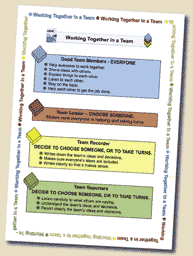| Approach: Team |
Level:
Year 8 |
|
| Focus:
Testing
wet strength
|
| Resources:
2 x four
types of different paper samples marked A,B,C,D; 6 rubber bands;
jug; 4 marbles; 4 jars; bowl of water; tray; “Working Together”
team guide |
 |
68KB |
|
|
| Questions/instructions
Discuss/review
“Working Together” Team Guide.
Some papers need to be strong when they are wet; like tissues, toilet
paper and paper towels.
Hand out and identify one sample of each of the 4 papers.
[A = newsprint; B = coffee filter; C = paper
towel; D = tissue]
In your team you are going to design a test to find out which of
these four papers is the strongest when it is wet. The test needs
to be a fair test. In a fair test, only one important thing is changed
at a time. For example, the size of the paper. Before you do your
test you need to talk about how you will do it and how you will
make sure it is a fair test.
Here is the equipment you can use for your test.
Hand out equipment. |

[click on guide for enlargement]
|
Talk about
how you will do your test so that it’s a fair test.
But don’t start it yet.
Allow time for team discussion. |
|
| |
%
responses |
| y8
|
| 1.
Now explain to me how you will do the test. |
|
| 2.
What will you be doing so that your test is a fair test? |
|
Now
you can do your experiment.
Allow time. |
|
Planning
of test:
|
planned
to set up 4 samples in same way |
86 |
planned
equal addition of water |
74 |
planned
how strength would be tested/measured |
72 |
discussed
value of repeating test with new samples of same paper (replication)
|
8 |
Overall
rating for quality of planning:
|
high
|
8 |
quite
high |
19 |
moderate
|
43 |
low
|
30 |
Conducting
test:
|
set
up 4 samples consistently |
87 |
controlled
equal addition of water |
64 |
observed
results carefully using consistent criteria |
61 |
recorded
results |
7 |
replication,
without teacher prompting |
19 |
Overall
rating for quality of experimentation:
|
high
|
5 |
quite
high |
31 |
moderate
|
38 |
low
|
26 |
You’ve
thought up and done your experiment. Have a team talk about how well your
test went. You might want to change things and try the test again. You
can talk about that now, and if you want, you can try to improve your
test, or do a different test.
Allow time. |
|
How
well did they discuss the probable consistency of results if test repeated:
|
well
|
15 |
moderately
well |
48 |
poorly
|
37 |
|
If students make changes to the experiment then ask questions
3 and 4: |
|
3.
What did you do to improve or change your test?
|
not
marked |
• |
| 4.
How did that improve your test? |
not
marked |
• |
| 5.
What did you find out about the strength of the papers when they are wet?
|
not
recorded here |
• |
| 6.
Do you think you would get the same result if you did the test again?
|
not
marked |
• |
7.
What was it about how you did your test that makes you think you could
get the same result again?
|
not
marked |
• |
|
|
|
|
Total
score:
|
13–16
|
8 |
10–12
|
26 |
7–9
|
25 |
4–6
|
27 |
0–3
|
14 |
Commentary:
The experimental
arrangement suggested by the resources provided did not work very well,
because the papers with higher wet strength were hard to distinguish.
Very little attention was given to the desirability of replication, although
multiple samples of paper were available.
|